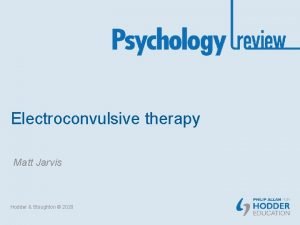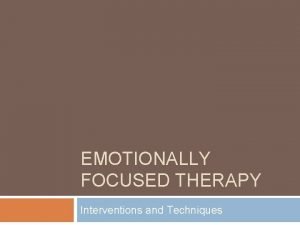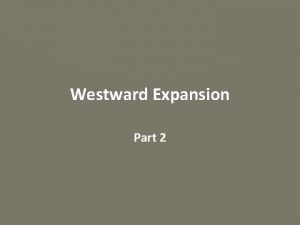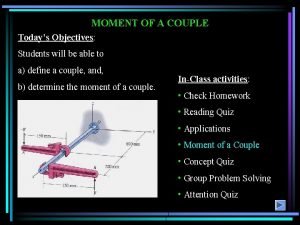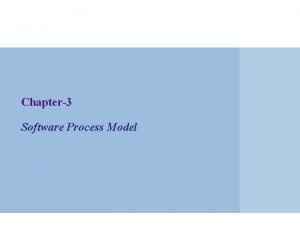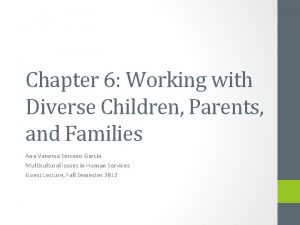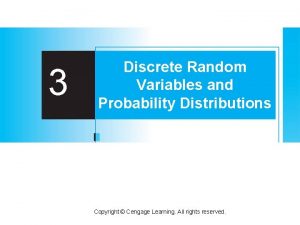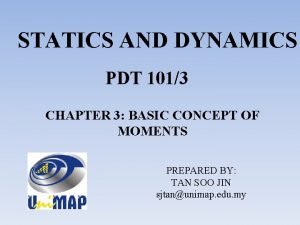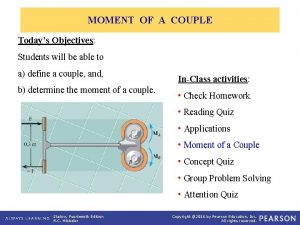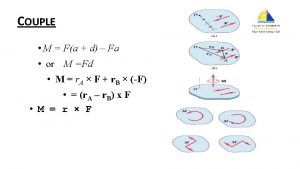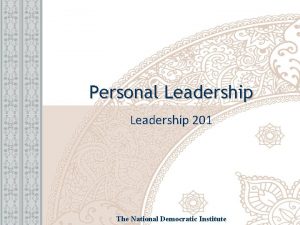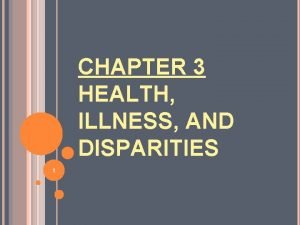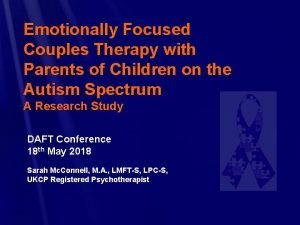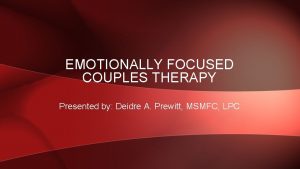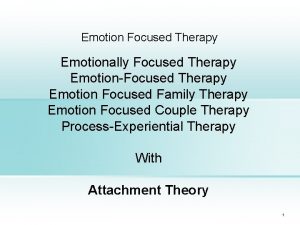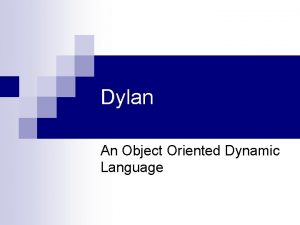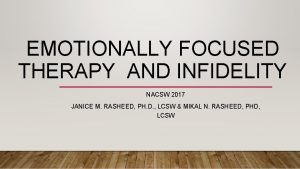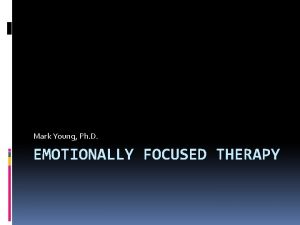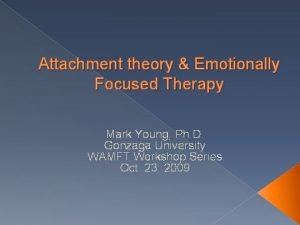Emotionally Focussed Therapy for Couples LUCINDA JOHNS DYLAN





















- Slides: 21

Emotionally Focussed Therapy for Couples LUCINDA JOHNS DYLAN EVANS

Introduction and Development of EFT Emotionally Focused Therapy for couples was conceptualized and published by Dr. Susan Johnson and Dr. Leslie Greenberg in the 1980 s. EFT arose from systematic observation of couples in therapy and the process by which they succeeded in repairing their relationships.

Basic Overview EFT is a process experiential approach focused on promoting more secure patterns of interaction EFT facilitates the adaptive expression of emotional experience and attachment related needs between partners. EFT views couple distress as being maintained by absorbing negative affect. Negative affect both reflects and primes rigid, constricted patterns of interaction. These patterns make the safe emotional engagement necessary for secure bonding impossible.

Goals of EFT The goals of EFT are to: • Access, expand re-organize key emotional responses. • Create a shift in partner’s interactional positions. • Foster the creation of a secure bond between partners through the creation of new interactional events that redefine the relationship so that each partner becomes a source of security, protection, and contact comfort for each other. Focus on: • Emotional engagement • Corrective Experience • Rather than skill building, renegotiated bargains, insight, communication skills, past trauma

EFT Journey FROM TO Alienation Emotional Engagement Vigilant defence and Self protection Openness and risk taking Passive helplessness Actively create interactions Desperate blaming Sense of how each partner makes it difficult for the other to be responsive and caring Focus on the other’s flaws Discovery of one’s own fears and longings Isolation Connectedness

Research into effectiveness of EFT A meta-analysis of EFT studies demonstrate a 70 – 73% rate of recovery from marital distress in 10 -12 sessions and an effect size of 1. 31 for the four outcome studies (Johnson, 2003). Two-year follow-up on relationship distress, depression, and parental stress – 60% of couples maintain gains or continue to improve. Predictors of success: Alliance with therapist Female partner’s faith in her partner’s caring Effectiveness with couples where the male partner withdraws and has difficulty in expressing emotion.

Theoretical Base Synthesis of: Humanistic experiential therapy: focus on empathic understanding of clients experience and understanding their behaviour as adaptive. Intrapersonal focus: within Systemic Therapy (Minuchin): focus on interactions and circular causality. Interpersonal focus: between Attachment theory (Bowlby): Attachment is an innate motivating force throughout the life span. Seeking and maintaining contact with significant others is a primary motivating force that is a part of humans from the cradle to the grave. Dependency is an innate, healthy part of our beings and not something we grow out of (Bowlby, 1988). Application of child attachment research to adult love relationships e. g. strange situation

Importance of Attachment Isolation is dangerous (heart attack / stroke risk doubles) Relationship distress elevates cortisol levels. Conflict depresses immune system – slows healing Rejection / exclusion trigger same circuits as physical pain Secure attachment complements autonomy: The more securely attached we are, the more separate and independent we can be. Attachment regulates our emotions and experiences

Attachment and emotional regulation Threat of electric shock while holding their husband's hand, the hand of an anonymous male experimenter, or no hand at all (Coan, Schaefer and Davidson: 2006)

Insecure Attachment The response, when a partner is perceived as not being dependable can be organized along two dimensions: anxiety and avoidance Anxiety: Attachment behaviors become heightened and intense and may include anxious clinging, pursuit, and aggressive attempts to get a response. Angry criticism and pursuing behaviors are often an attempt to modify the other partner’s inaccessibility. Also a protest response to isolation and abandonment by the partner. Avoidant Withdrawal: An attempt to contain the interaction and regulate fears of rejection. An attempt to avoid confirming working models that define the self as unlovable. (if you really knew who I was you wouldn’t love me)

Focus on Emotion organises attachment behaviours Orients and motivates us to respond to others and communicates our needs Organises the way self and the other are experienced in relationship. Emotional accessibility and responsiveness are the building blocks of secure bonds. Emotion occurs at two levels: Primary and Secondary Primary emotions are the deeper, more vulnerable emotions like sadness, fear, hurt and loneliness. Often the initial reactions. If expressed often draws partners closer. Secondary emotions are the more reactive emotions such as anger, resentment, jealousy and frustration. They occur as a reaction to primary emotions and tend to push partners away. Goal is often to expand the person’s awareness and expression of emotion from secondary emotions to primary emotions.

Insecure Cycles Insecure attachment leads to negative interactional cycles, and in return, negative interactional cycles lead to insecure attachment (circular) In trying to connect (get attachment needs met), distressed couples get caught in negative repetitive sequences of interaction where partners express secondary (reactive) emotions rather than primary emotions.


The 3 stages: Nine Steps of EFT Cycle de-escalation: Step 1: Create an alliance Step 2: Identify the negative cycle Step 3: Help them talk about their primary emotions underneath the position they take Step 4: Reframe the problem in attachment terms Changing interactional positions: Step 5: Help the couple redefine their experiences in terms of their unacknowledged emotional needs Step 6: Get each partner to hear, believe and accept the other’s emotional needs Step 7: Help them to express their emotional needs and wants directly rather than through old patterns Consolidation/integration: Step 8: Facilitate new solutions to old problems Step 9: Consolidate new positions and attachment

5 Basic Moves of EFT

The Contraindications for EFT In order for EFT to be successful, safety is necessary. These contraindications undermine the safety needed for vulnerability to be expressed: ABUSE : ongoing violence physical or emotional ADDICTIONS: ongoing addictions of all kinds AFFAIRS: continued emotional, physical or sexual contact

Video Example EFT Couple therapy example. mp 4 EFT roleplay. mp 4 EFT cycle example. mp 4

Up and coming Training http: //www. eftsouthafrica. com/ EFT Four Day Hillcrest Externship 24 -27 November 2018 Presenter: Dr Jenny Fitzgerald, Clinical Psychologist and EFT trainer Augusta Country Estate, Hillcrest Cost: R 4500 Early Bird by 30 June, or R 5000 after 30 June Accredited with the HPCSA for 27 general CEU’s EFT Advanced Externship – 29 & 30 November 2018 Cost: R 2000 Early Bird by 30 June, or R 2300 after 30 June Accredited with the HPCSA for 12 general CEU’s on level 1 One Day Workshop: Using EFT to Help Couples with Infidelity – 1 Dec 2018 Cost: R 1250 Early Bird by 30 June, or R 1500 after 30 June Accredited with the HPCSA for 6 general CEU’s on level 1

Reading

Attachment Injury resolution model The injured partner begins to describe the incident in which he or she felt betrayed, abandoned, and helpless, and experienced a violation of trust that damaged his or her belief in the relationship as a secure bond. With therapist’s help, the injured spouse stays in touch with the injury and begins explicitly to articulate its impact and attachment significance. Newly formulated emotions frequently emerge at this point. Anger often evolves into vivid, clear expressions of hurt, helplessness, fear, and shame. The connection of the injury to the present negative cycles in the relationship becomes clear. The partner, supported by therapist, begins to hear and understand the significance of the wounding event, and to understand it in attachment terms as a reflection of his or her importance to the injured partner, rather than as a reflection of his or her personal inadequacies or “crimes. ” This partner is then guided to acknowledge the injured partner’s pain and suffering, and to elaborate on how the wounding event evolved for him or her, so that his or her actions become clear and understandable to the injured partner.

The injured partner then tentatively moves toward a more integrated and complete articulation of the injury. A core moment of pain and wounding where loss and despair flooded this partner is often pinpointed. With the help of therapist, the negative shift in cognitions about the self, the partner, and the viability of secure connection and the tsunami of emotions and body sensations and coping strategies are made into a coherent and organized narrative. This encapsulates the loss surrounding the injury and specific attachment fears and longing. This partner, supported by therapist, allows the other to witness his or her vulnerability. The other spouse now becomes more emotionally engaged and acknowledges responsibility for his or her part in the attachment injury or infidelity and is able to express empathy, regret, and/or remorse in a direct, congruent, and emotionally engaged manner. Supported by therapist, the injured spouse then risks asking for the comfort and caring from the partner that were unavailable at the time of the injurious event, the discovery of the infidelity, or the couple’s previous discussions of the infidelity or injury. The other spouse responds in a caring manner that acts as an antidote to the traumatic experience of the attachment injury. The partners are then able to construct together a new narrative of the injury. This narrative is ordered and includes, for the injured partner, a clear and acceptable sense of how the other came to respond in a defensive manner or became involved with another person and how this crisis in their relationship is able to be resolved.
 Lucinda johns
Lucinda johns Eunice and charlie johns
Eunice and charlie johns Stoughton couples therapy
Stoughton couples therapy Encounter group therapy examples
Encounter group therapy examples Emotionally focused therapy techniques
Emotionally focused therapy techniques Lucinda kennedy
Lucinda kennedy Lucinda ringe
Lucinda ringe Facade pattern couples a subsystem from its clients
Facade pattern couples a subsystem from its clients Two couples act on the beam as shown
Two couples act on the beam as shown Destructive love in the great gatsby
Destructive love in the great gatsby Software requirement and design
Software requirement and design Academic couples
Academic couples Bicultural couples tend to demonstrate extremes in
Bicultural couples tend to demonstrate extremes in A pediatrician wishes to recruit 5 couples
A pediatrician wishes to recruit 5 couples Two couples act on the beam as shown
Two couples act on the beam as shown What remedy corrects the crossed-loved couples
What remedy corrects the crossed-loved couples Two couples act on the beam
Two couples act on the beam Statics couples
Statics couples Corporate athlete model
Corporate athlete model Personal leadership statement
Personal leadership statement Emotionally healthy schools
Emotionally healthy schools Mentally spiritually physically emotionally
Mentally spiritually physically emotionally


